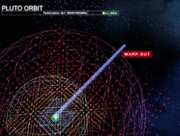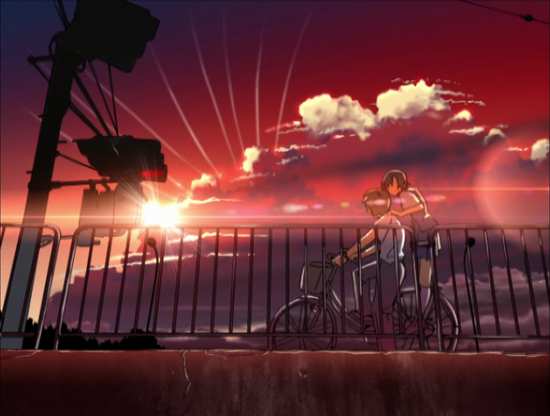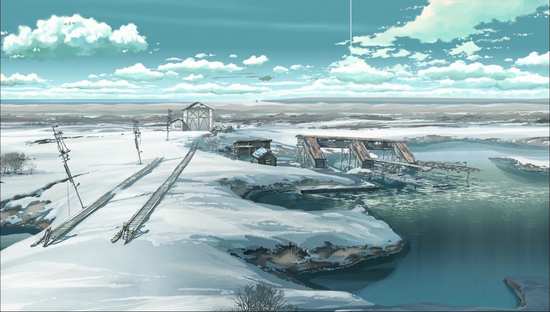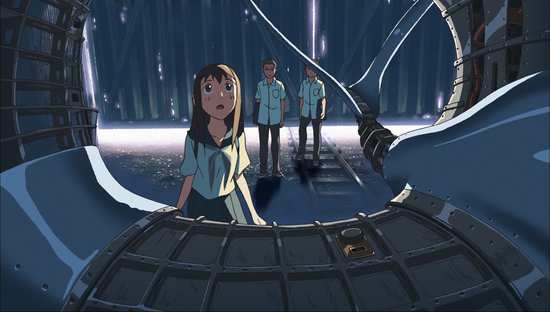Review for The Place Promised in Our Early Days / Voices of a Distant Star Twin Pack
Introduction
It’s finally here! One of All the Anime’s earliest licence announcements has made it to release, although it’s had quite the road to travel. The initial announcement was for the Shinkai twin-pack, bringing Voices of a Distant Star and The Place Promised in Our Early Days to Blu-ray, but things got quite ambitious thereafter, with thoughts of an Ultimate Shinkai release mooted, adding 5 Centimeters Per Second, Journey to Agartha, and following its release, Garden of Words as well. There was even some thought of some of Shinkai’s commercial work and other short films. If you know the difficulty Manga Entertainment had just trying and failing to get 5 Centimeters Per Second out here on Blu-ray, you can see why the project was scaled back to just the twin-pack again. In essence this release replicates the original ADV Shinkai twin-pack, albeit in HD, and if you’ve seen any of Makoto Shinkai’s work, you’ll know that his films deserve the high definition treatment.
I’ve been looking forward to upgrading my ADV discs, what with the sound sync error on Voices of a Distant Star, although that release also came with a comprehensive 44 page booklet, brimming with information about the films, and no little artwork. I only have the Blu-ray check disc this time, so I can’t comment on the DVDs, the packaging or the artbook that you get with the All the Anime release, although hopefully the latter is as comprehensive as ADV’s booklet. Incidentally, both films and all of the extras are on the one Blu-ray disc.
The disc boots up to a static menu, where you can choose the audio options for the disc, the extras for both films in their appropriate lists, and the films themselves.
Introduction: Voices of a Distant Star
It’s the middle of the 21st Century, and mankind is expanding into space, exploring the solar system and even colonising other worlds. It’s on Mars that aliens are first encountered, but the first contact with the Tarsians is devastating, and a conflict erupts. It’s the discovery of Tarsian technology that allows mankind to pursue the war, to upgrade their ships to travel faster than light, and the plan is to track the Tarsians down to ensure humanity’s safety.
Noboru and Mikako are middle school students whose friendship is slowly developing into something deeper. Except that Mikako is selected to join the force that is going out to track the Tarsians. Her life becomes a mixture of training and tense situations, as she goes to Mars, and then Jupiter as part of her training, and then to the edges of the solar system and beyond to track down and combat the Tarsians. For her it’s a matter of hard work and combat, interspersed with brief moments of melancholy when she recalls the normal world that she has left behind, and the only contact remaining to her, her mobile phone that she uses to text Noboru. For Noboru, his life is supposed to continue as before, going to high school and living his everyday life, but he’s left waiting for Mikako’s e-mails, the distance being just minutes and hours at first, then stretching to months and even years the further away from Earth that she travels.
Picture: Voices of a Distant Star
There wasn’t a lot that could be done with Voices of a Distant Star, as it is a small scale SD animation to begin with. What we get here is a 4:3 pillarboxed transfer, scaled up to 1080i 60Hz format. Quite naturally the image is soft, and it’s prone to banding, and the interlaced format means that it isn’t quite as smooth as a progressive transfer. It’s pretty much DVD quality, albeit with practically no compression, and richer colours, and it’s certainly a step up over ADV’s NTSC-PAL standards conversion. The animation is pretty simple, with tricks used to make most of the dialogue happen off screen, and the character designs are also pretty simplistic. That aside, Voices of a Distant Star is absolutely gorgeous when it comes to the world design, the pastel shades, the use of light and filters. It really is an artwork brought to life, and you can see Shinkai’s unique style established early on.
Sound: Voices of a Distant Star
You have the choice between DTS-HD MA 5.1 Surround English, Dolby Digital 5.1 Surround Japanese, and PCM 2.0 Stereo English and Japanese, with optional translated subtitles and a signs only track.
And it happened again! The Japanese surround audio is out of sync on this disc, and this time it’s out by over a quarter of a second, meaning I can’t compensate for it with my Blu-ray player’s settings, as I did for the old DVD. But it isn’t quite as bad as you might think. If you go to the extras and select the Alternate Japanese Audio, you will instead get the DD 5.1 Japanese audio but this time synchronised to the image. Of course this means that one of the extras is missing. More importantly we get the stereo track, which we never did before, and the uncompressed 2.3Mb stereo track has far more in the way of fidelity and richness than the comparatively tinny 448kb surround track. The dialogue is clear, and the subtitles are accurately timed, although look to use the same ADV assets; some of the text translations aren’t on screen long enough to read and the same typos are there. The English 5.1 provides a nice bit of ambience, bringing out the action sequences on the film. It also highlights Tenmon’s evocative score for the piece, and the dialogue is clear on all versions.
Extras: Voices of a Distant Star
The extras for the film are almost the same as that original DVD release.
Alternate Japanese Audio should have been the film with the original scratch track with Makoto Shinkai and Mika Shinohara in the roles of Noboru and Mikako. But in an error, we get the main Japanese 5.1 track again, this time in sync to the image.
The She and Her Cat Short is here, running to 4:45, presented in 1080i 60Hz monochrome upscale with PCM 2.0 Japanese audio with subtitles. It’s a tale of a cat and his new owner, narrated from the cat’s point of view. It’s the story of their life together, and is an evocative piece, reflective and melancholy. What’s surprising is that you can see Shinkai’s eye for detail, and his stunning use of shade and light, even in something lacking in colour. Note that the shorter and digest versions that were on the ADV release have been left off the Blu-ray.
The interview with Makoto Shinkai lasts 8:31 and is presented in 480i with PCM 2.0 Japanese audio.
The Original Production Animatic lasts 23:09 minutes, is itself in monochrome, and offers Voices of a Distant Star in storyboard form, with occasional unfinished CGI and unfinished animation. Again this is in 480i.
The trailer collection lasts 4:52 and is in 480i. There are three trailers as opposed to the four that were on the ADV release.
There’s less in the way of trailers and She and Her Cat animations, and the Shinkai scratch track is missing. All in all, it might be worth holding onto that ADV disc.
Conclusion: Voices of a Distant Star
Voices of a Distant Star is about a love torn apart by space and time, and it will be only the most iron-willed of viewers who won’t be troubled by a quivering lip, or a moistening of the eyes. Voices of a Distant Star effortlessly captures the emotions of its protagonists, making real the distance and alienation that we so often metaphorically experience in our own lives.
The harshest thing is that Noboru and Mikako’s love is one that never really had a chance to happen, is a whole lot of lingering what-ifs that haunt the both of them after their separation. For Mikako, it’s always a now thing, for her time flows normally, she doesn’t age, she moves from one difficult situation to the next, pausing only briefly to think of all that she’s had to give up, and holding onto the lifeline that is her mobile phone, her one connection to all that was normal. The sad thing is that she’s completely aware that time is moving at a different rate for Noboru, that each message that she sends reaches him further and further apart in time, that the boy she knew doesn’t even exist anymore.
For Noboru, what could have been a pleasant childhood memory, a warm melancholy time in his life, turns into a wound that never heals. For anyone else such friendships that are torn apart by distance gradually fade, as both parties find new lives and new friends, and slowly stop communicating. At first this looks inevitable, as they are reduced to texting each other across the solar system, but the further that Mikako goes from the Earth, the longer it takes for her messages to reach him. Waiting a few hours or days for a response is one thing, but when it comes down to waiting for months and even years, it’s like having a void in your life that slowly begins diminish, only to be hollowed out anew when a few years later a new message arrives, from a person who in her perspective is only a few hours older than before.
Voices of a Distant Star is a peach of a short movie, which gets a healthy assortment of extra features. The shame is that extra features are missing on this disc compared to the DVD. Otherwise the English dub is very serviceable, and at least this time there is actually a superior Japanese stereo option. Back when I reviewed the DVD, I had hoped that it wouldn’t take too long for the licence to be renewed. Best part of a decade isn’t that long!
7/10
Introduction: The Place Promised in Our Early Days
It was an idyllic summer for school friends Hiroki, Takuya, and Sayuri. They were growing up in an alternate post-war Japan where North and South had been sundered by US and Union forces, and the prospect of war always loomed high. But there was something about that perfect summer in Middle School that was just special. Hiroki and Takuya got part time jobs assembling missiles in a factory, but their real dream was to build and fly an aeroplane. They spent all their free time working on the project, and when Sayuri found out, she supported them in their dream. This urge to fly was inspired by the constant vision of the Tower. An edifice reaching high up to the stars on the Union island of Ezo, what was once called Hokkaido. No one knew exactly what its purpose was, but it was visible, even as far away as Tokyo. Hiroki promised Sayuri that once the plane was completed, they would fly together to the Tower. Then one day, Sayuri didn’t come, and she was never heard from again.
Three years pass, and the tensions between North and South increase. Takuya now works in a research facility, and knows more about the Tower than flying past it could ever have revealed. Both sides are engaged in a new kind of arms race, and with the Tower, the Union side has had a major head start. Takuya is working with the team that is trying to catch up. Hiroki on the other hand simply started high school in Tokyo, and tried in vain to put that summer behind him. But he’s haunted by the past, haunted by Sayuri, and haunted by the promise that he couldn’t keep. The researchers may have made a breakthrough though. There’s a girl comatose in a Tokyo hospital, whose dreams seem connected to the Tower and understanding why may give the North the edge. She’s Sayuri of course, who fell asleep three years ago, never to wake up. In her dreams, she’s been reaching out to Hiroki, and he comes to realise that only by fulfilling the promise will she wake up. But Takuya learns that if she wakes up, it may mean disaster for them all.
Picture: The Place Promised in Our Early Days
The Place Promised In Our Early Days gets a 1.78:1 widescreen 1080p transfer, which is clear, sharp, and with no issues regarding compression or banding. It’s a beautiful transfer, which does the film full justice. It’ s a glorious HD transfer which blows the previous DVD release away, and even more than on that DVD, Shinkai’s fantastic colour palette comes to the fore. You can see the same directorial flair displayed in Voices of a Distant Star carried through here. The use of colour, of light, and brightness and unconventional framing is truly breathtaking. But you can also see the steps forward in the quality of the film, detail and resolution is greater, the animation is much more robust, and character designs aren’t as flat, and while exhibiting Shinkai’s style, are also a little more conventional when it comes to anime.
Sound: The Place Promised in Our Early Days
This time the audio choice is straightforward, with no issues when it comes to sync. You have the choice between DTS-HD MA 5.1 Surround and PCM 2.0 Stereo, both in English and Japanese, and with optional translated subtitles and a signs only track; again with the lingering ADV script typo. Given that this is a film that has a fair bit of action in between the melancholy, the soundstage is well used in bringing out the discrete audio placement. Tenmon’s music is once more gentle and anthemic. A feature of Shinkai’s films is that he doesn’t normally cast the typical voice actors in his main roles, rather he goes for actors from other disciplines such as television or live action film, and that difference does tell in the Japanese dub. Not so in the English dub, which is typical ADV, easy to listen to, but not quite on the same level as the Japanese.
Extras: The Place Promised in Our Early Days
The extras for this film are brought over from the DVD release again, and comprise the interviews with the cast and the director. You can select from Masato Hagiwara (Takuya) 10:59, Hidetaka Yoshioka (Hiroki) 9:46, Yuuka Nanri (Sayuri) 11:50, and director Makoto Shinkai, who speaks for 12:30. You can learn a lot about the characters and the actors’ experiences in recording the roles. There’s much about the film, and Shinkai talks about the making of the film, and working as part of a collaborative effort for a change. All of these featurettes are in SD, as is the Trailer Collection, which runs to 7:03, and once again it seems that not all of the trailers from the DVD have made it across.
Conclusion: The Place Promised in Our Early Days
The Place Promised in Our Early Days is still my favourite Shinkai film after all this time, although I am yet to see Your Name. Shinkai’s films explore common themes of separation, loss and regret. It’s all about the flavour of emotion, intense melancholy, infusions of nostalgia, all of which comes through with the measured pace of the storytelling, the introspection, self analysis and narrative of the main characters, and the rich, ideal world imagery. It seemed like a new way of doing things in Voices of a Distant Star, and it reaches an emotional pinnacle in 5 Centimeters Per Second, but in The Place Promised In Our Early Days, with its sci-fi storyline, it has a grand and panoramic scope that takes the breath away. This is a film so beautiful that it hurts the eyes. The reason why this film is my favourite, is that given Shinkai’s exploration of separation, loss and regret, this film is the closest that you get to a happy ending.
Once again however, it’s a case where the sentiment of the piece overwhelms the narrative. It’s a film that tells its emotional arc first and foremost, and the narrative, the ideas and concepts behind the story are only there to motivate that arc. If you’re switched on to the story more than the characters, you may scratch your head at one or two whopping great loose ends, but if instead you are invested in the journey that Hiroki, Sayuri and Takuya take, then the warm glow that the film leaves you with will lift you no end.
Despite this, Early Days still has the strongest narrative of the Shinkai films that I have seen, and makes the most compelling use of its sci-fi concepts. The alternate history Japan has just enough of a twisted sideways design ethic to make it stand in contrast against the real world, and just as I recognised elements of Distant Star in Fumihiko Sori’s To, I was tickled by the echoes I saw of The Wings of Honneamise. This film too pits hopeless idealism against harsh reality, leading to a conclusion that takes place against the background of war. The idea of Sayuri’s three year long slumber reminded me a little of the ‘Standstills’ of Please Teacher, while the central conceit of the Tower and the arms race between the North and South had touches of Noein to it. But just like Voices of a Distant Star, and its Twin Paradox storyline, this film uses its building blocks to tell the emotional journey of its characters, and you never really get too involved with the mechanics of its concepts, or overwhelmed by jargon. You’ll be too misty eyed before it even becomes an issue.
The Place Promised In Our Early Days is a peach of a film, a reminder that cinema is a visual and aural medium first and foremost, and that film can affect you on a far more fundamental and basic level that narrative and story alone ever can.
9/10
In Summary
It’s been a lengthy wait, but the end result is definitely worth it. You may think that the sound sync problem on Voices of a Distant Star would be a problem, but instead of the Shinkai audio version in the extras, the disc just repeats the Japanese 5.1 track again, this time in sync, while the stereo offering for that short film on Blu-ray is actually superior to the surround track.
The real joy is in The Place Promised in Our Early Days, which has an animation that really comes alive in high definition. You can see all of Shinkai’s artistry here, the play of light and shadow, the beautiful colours, and more importantly the exquisite detail in his backgrounds. If you’ve never seen this film in high definition, then you’ve never really seen this film at all. There’s nothing new on the disc in terms of extra features, although given how well endowed ADV’s DVD release was, that’s not really a problem, although some new material would have been appreciated. Still, if you are looking to double dip on the old DVD release, don’t hesitate!



















































































Your Opinions and Comments
Be the first to post a comment!